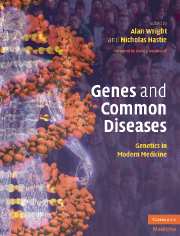Book contents
- Frontmatter
- Contents
- List of Contributors
- Foreword
- Section 1 Introductory Principles
- 1 Genes and their expression
- 2 Epigenetic modification of chromatin
- 3 Population genetics and disease
- 4 Mapping common disease genes
- 5 Population diversity, genomes and disease
- 6 Study design in mapping complex disease traits
- 7 Diseases of protein misfolding
- 8 Aging and disease
- 9 The MHC paradigm: genetic variation and complex disease
- 10 Lessons from single gene disorders
- 11 Environment and disease
- 12 Contemporary ethico-legal issues in genetics
- Section 2 Common Medical Disorders
- Index
- References
8 - Aging and disease
Published online by Cambridge University Press: 17 August 2009
- Frontmatter
- Contents
- List of Contributors
- Foreword
- Section 1 Introductory Principles
- 1 Genes and their expression
- 2 Epigenetic modification of chromatin
- 3 Population genetics and disease
- 4 Mapping common disease genes
- 5 Population diversity, genomes and disease
- 6 Study design in mapping complex disease traits
- 7 Diseases of protein misfolding
- 8 Aging and disease
- 9 The MHC paradigm: genetic variation and complex disease
- 10 Lessons from single gene disorders
- 11 Environment and disease
- 12 Contemporary ethico-legal issues in genetics
- Section 2 Common Medical Disorders
- Index
- References
Summary
Is achieving extreme old age worthwhile? The centenarian phenotype
Average life expectancy has markedly increased over the past century. In 1900 average life expectancy was 46 years and in the United States it is currently almost 79 years. The age 85+ group is the fastest growing segment of our population and within that group, the number of centenarians is growing even faster. Whether mortality declines have been accompanied by health improvements among the elderly has been a matter of debate. Some authors have suggested that mortality declines have led to increased prevalence of frailty among older survivors because treatment of existing diseases simply postpones death to older ages (Gruenberg, 1977; Kramer, 1983; Olshansky and Ault, 1986), while others suggest that mortality declines have led to a compression of morbidity (Fries, 1980). Early US evidence from the 1970s was generally consistent with the idea that health among the elderly had deteriorated (Crimmins and Ingegneri, 1993; Verbrugge, 1984), while more recent evidence provides a somewhat more optimistic view (Freedman and Soldo, 1994; Manton et al., 1997). Changes in disability prevalence over time, however, have varied by type and severity and by the data source used for trend analyses (Waidmann and Manton, 1998).
Centenarians studied by Hitt et al. appear to fit the pattern of postponement of disability to very advanced ages. In a population-based sample, it was observed that 90% of centenarians were independently functioning at age 92 (Hitt et al., 1999).
- Type
- Chapter
- Information
- Genes and Common DiseasesGenetics in Modern Medicine, pp. 132 - 141Publisher: Cambridge University PressPrint publication year: 2007



